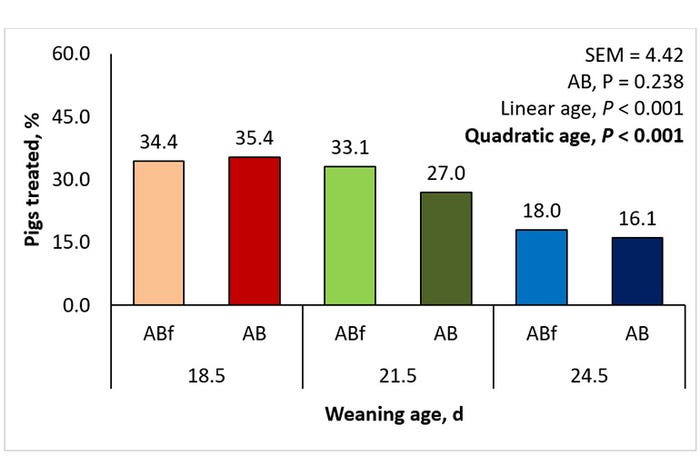Weaning age and antibiotic use for pigs evaluated
The capacity to produce more "antibiotic-free" pigs and more pork per weaned pig suggests that age at weaning should be increased.
July 9, 2020

While at Kansas State University almost two decades ago, Rodger Main conducted a large study to assess the impact of weaning age on performance in a commercial system. The range of weaning ages used in that work was from 12 to 21.5 days, which was very applicable to the swine production of that time.
Most of the findings of that study exhibited improvements such as growth rate, mortality and weight sold per pig weaned as weaning age increased, reinforcing the necessity to evaluate an older range of weaning ages.
As pressure to lower antibiotic use increases, a renewed look at weaning age appears warranted to maintain economically competitiveness of pork production. To our knowledge, there is limited data evaluating different weaning ages combined with or without the use of antibiotics in the wean-to-finish period. Although the antibiotic-free market is growing, controlled studies assessing the effects of raising pigs without antibiotics in commercial environments are scarce. Therefore, the study's objective was to determine the effects of weaning age and antibiotic use on pig performance in a commercial production system.
A total of 2,184 barrows and gilts (DNA 600, Columbus, Neb., × PIC L42, Hendersonville, Tenn.) from four consecutive weaning batches were used in a study from weaning to market at 197 days of age. The study started in a 4,000-sow farm, and at birth, pigs were ear-tagged with different colored tags to identify the exact age at weaning. Three weaning age categories (18.5, 21.5 and 24.5 days) were created by weaning litters at 18 and 19, 21 and 22, or 24 and 25 days of age. Pigs were placed into a wean-to-finish research facility with each pen containing 13 barrows and 13 gilts. Pens of pigs were then weighed and randomly assigned to an antibiotic or antibiotic-free program. Pigs assigned to the antibiotic program had access to a diet containing 400 grams per ton chlortetracycline from Day 8 to 21 post-weaning.
After a porcine reproductive and respiratory syndrome outbreak at Week 7 post-weaning, they were medicated via drinking water for five consecutive days with CTC (22 milligrams per kilogram body weight per day). The water system allowed medicating specific pens. Thus, it was possible to give access to medicated water after the PRRS outbreak just to pigs assigned to the antibiotic program. Injectable antibiotics were given as needed regardless of dietary treatment, with all treatments individually recorded.
There were no interactions between weaning age and antibiotic program. From weaning to 197 days of age, increasing weaning age improved average daily gain, average daily feed intake and final body weight (Table 1).

Increasing weaning age from 18.5 to 24.5 days also resulted in a marginal decrease of the wean-to-finish losses, and increased the weight sold per pig weaned (Figure 1). Moreover, the percentage of pigs treated with an injectable antibiotic was reduced as weaning age increased.
The use of antibiotic in the feed and water improved growth rate and feed intake (Table 1). An interaction was observed for feed efficiency. In the antibiotic-free program, increasing weaning age improved feed efficiency, but when antibiotic was provided, increasing weaning age did not result in any change in feed efficiency. In addition, pigs with access to antibiotic in feed and water had lower total losses, and greater weight sold per pig weaned. Providing antibiotics in the feed and water did not impact the percentage of pigs treated with an injectable antibiotic (Figure 1).

In summary, increasing weaning age and relatively short-term use of antibiotics had a significant impact in the wean-to-finish closeout. The antibiotic effect in survivability is relevant, and the capacity to produce more "antibiotic-free" pigs and more pork per weaned pig suggests that age at weaning should be increased.
Sources: Jamil E. G. Faccin, Mike D. Tokach, Jason C. Woodworth, Joel M. DeRouchey, Steve S. Dritz and Robert D. Goodband, who are solely responsible for the information provided, and wholly own the information. Informa Business Media and all its subsidiaries are not responsible for any of the content contained in this information asset.
You May Also Like



